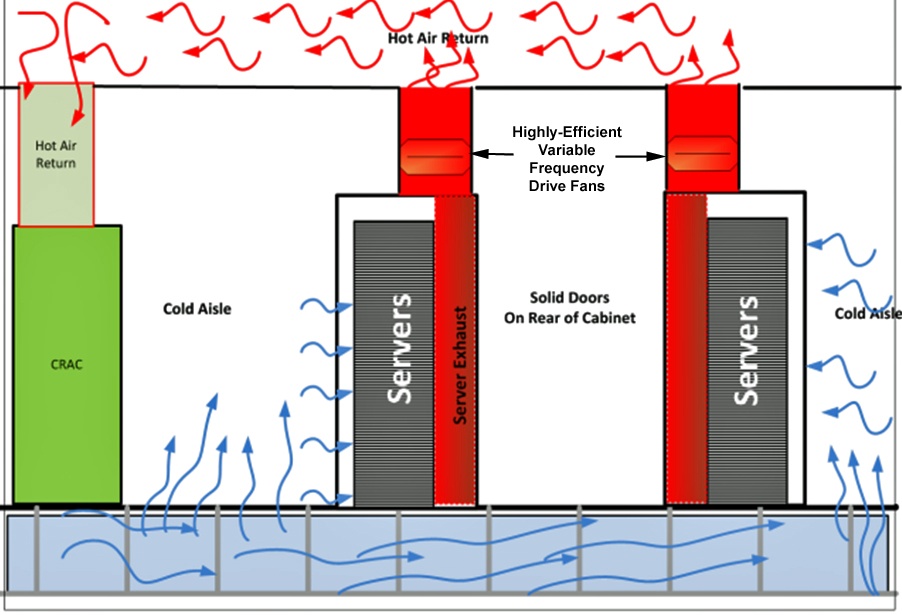Un examen plus approfondi du confinement des cheminées actives
Dans mon dernier blog, nous avons examiné le confinement des cheminées passives comme moyen de séparer l'air chaud et l'air froid dans le centre de données.
L'un des principaux défis rencontrés pour assurer l'efficacité d'un centre de données est de trouver le bon équilibre entre la température de l'allée froide, la vitesse du ventilateur de l'équipement informatique et la température de retour de l'air chaud. Bien qu'il ne soit pas toujours facile de maintenir un équilibre parfait, le confinement des cheminées actives peut permettre d'atteindre un niveau d'efficacité optimal, en particulier dans les environnements à forte densité.
The Active Approach
Unlike passive chimney solutions, an active chimney includes intelligence or components that actively move air from the hot aisle side of the cabinet to the CRAC/CRAH return.

There are a variety of active chimneys available that use different active components to effectively move the air. Belden's active Adaptive Enclosure Heat Containment (AEHC) system contains variable frequency drive fans and a control unit that adjusts the fan speed based on air pressure within the rear of the cabinet. That's right-I said air pressure NOT temperature. How does this work?
Let's assume that IT equipment is being added to a cabinet. This raises the cabinet temperature and creates more pressure in the rear of the cabinet. Rather than monitoring based on temperature only, The AEHC controller detects this change in pressure and increases the chimney fans accordingly to remove the additional heat and pressure.
One method of achieving energy efficiency is to raise the temperature of the cold aisle to where it enables the IT equipment's variable speed fans to operate at an optimal cubic feet per minute (CFM) rating for energy efficiency while still ensuring maximum life of the IT equipment. If an event occurs that raises the temperature of the cold aisle to a level where the IT equipment fans need to accelerate, it is safe to assume that the equipment exhaust will be hotter and pressure in the rear of the cabinet will increase.
In this scenario, the AEHC controller will again detect the change and increase the highly efficient chimney fan speed. When the cold aisle temperature is returned to normal and the IT equipment fans slow down to a normal energy-efficient state, the AEHC controller will react to the decrease in pressure and return the chimney fans to their normal energy-efficiency state. By varying the fan speed, the system conserves energy until it is needed and maintains the proper balance of the data center ecosystem.
More to Offer
Like passive chimneys, active chimneys can be deployed in both new and existing data centers. However, active chimneys are able to support much higher cabinet densities. This allows them to be shared between two or three cabinets depending on the total cabinet load. Belden's active AEHC system offers three fan options to suit a variety of cabinet needs-10, 20 and 30 kW-all of which are guaranteed to operate for six years of continuous use and are monitored by the on board controller software.
With two, hot swappable fan units, the AEHC system is also fault tolerant. When one fails, the other increases its speed to compensate for the failed fan until it is replaced. Via control units, active chimneys can also provide monitoring and alarming features-both of which are part of the Belden AECH controller's firmware.
While a passive chimney might be ideal for a 3 to 8 kW cabinet, active chimneys provide a more automated system to keep your higher density data center ecosystem in balance and allow flexibility for spot application.
For example, Belden's AEHC system can be used as a spot solution for low-density data centers that need to support a single device or cabinet that requires an active solution. Both passive and active chimneys can be deployed within the same data center, and Belden's AEHC system is available in both types to suit a variety of data center efficiency needs and scalable granularity levels as the data center grows and changes.
